Bassano B., Durio P., Gallo Orsi U., Macchi E
eds., 1992. Proceedings of the 1st Int. Symp. on
Alpine Marmot and genera Marmota. Torino.
Edition électronique, Ramousse R., International Marmot Network, Lyon 2002
OBSERVATIONS ON DISTRIBUTION AND ABUNDANCE OF THE ALPINE MARMOT (Marmota marmota L.) IN THE TERRITORY OF BELLUNO (SOUTH-EASTERN ALPS)
Chiesura Corona M.
Cattedra di Zoologia Forestale, Venatoria e Acquicoltura (Univ. di Padova)- Amministrazione Provinciale di Belluno
Abstract - The distribution of the alpine marmot has been considered from an ecological point of view in one area of the south-eastern Alps (province of Belluno). With the collaboration of the Administration of the Prov. of Belluno, through the availability of the Corp of Hunting and Fishing Vigilance, 85 sample-colonies have been studied. The following elements have been pointed out: air temperature, weather, UTM grid co-ordinates, altitude, exposure, slope, kind of soil and rock, presence of water, closeness of human settlement or hunt, predications, number of used and unused burrow holes, and finally, number of holes per unit of area.
The prevaling distribution of these different data and their possible correlation is discussed. This work is part of the "marmot-project", dispatched for the province of Belluno, in the ambit of the faunal arrangement plan.
INTRODUCTION
The aim of this research is mainly to bring up to date the distribution and to estimate the abundance of the alpine marmot (Marmota marmota L.) in the province of Belluno (fig. 1 and fig. 2).
To determine an environmental typology some ecological data have been pointed out. These data could be used for a correct management of the species, playing an important role in conservation. The data have been collected from May to September of 1991. 85 colonies chosen as sample have been studied.
RESULTS
Environmental characteristics Alpine marmot seems to prefer open areas characterized by rich alpine pasture. Colonies are usually located on meadows limited by trees and without rocks, or in areas with irregularly spread out and differently sized rocks.
2 categories of colonies are here considered: a) colonies located on alluvial ground (soft and deep soil); b) colonies located on a rocky ground (hard ad thin soil with outcropping rocks or total absence of grass). 16 colonies belong to a) category ad 69 colonies belong to b) category. For the colonies of b) category the kind of rock has been summarily classified. 57 colonies are placed on carbonate rock (calcareous and dolomite rock), 8 on volcanic rock and 4 on metamorphic rock.
However, in the province of Belluno the territory is almost completely developed on carbonate rock.
The analysis of the vegetation is in progress yet; the sampling was made through an observation of the most evident elements; colonies were visited in different vegetative periods. The results are: 1) the general environment is a typical alpine posture that grows on carbonate rock, that is acid meadow in the lower altitudes (Nardetum) and rich meadow in higher altitudes (Sesleria sp. and Carex sempervirens) (Reisigl & Keller, 1990); 2) In the highest altitude environments (stable and unstable moraines) we find Carex firma, Dryas octopetala and Silene acaulis (Reisigl & Keller, 1,c.); 3) forest trees are always absent; 4) shrubs (Pinus mugo, Rhododendron sp., Salix sp., etc...) are rare and typical of cool and humid settlements. The vegetation generally corresponds with the geomorphologic data (altitude, exposure, lithology, slope, and so on).
ALTITUDE
In every colony, altitude was measured by an altimeter (precision of the measurement = 50m). 10 bands of altitude (100m each) are considered in the interval 1400-2400 m.s.l. A Chi-square statistical analysis (x2 (9) = 25.70, P = 0.002) shows a non-casual distribution. The middle values (1700-2100m) are clearly preferred (fig. 3). Probably this choice is a consequence of different factors like thermoregulation (Türk & Arnold, 1988) and vegetation, more rich in this range of altitude.
EXPOSURE
Data on exposure were collected in 80 non flat colonies by a compass. 8 sides of exposure were considered. The non-casual distribution is showed by a Chi-square analysis (x2 (7) =49.60, P<0.001). South orientated colonies are more frequent; east orientated colonies are more frequent than west orientated ones (fig. 4). Thermoregulation plays surely an important role in this preference (Türk & Arnold, 1988).
SLOPE
The slope of the area of all the colonies is shared in 4 categories: a) null: 0°; b) slight: 1°-10°; c) medium: 11°-30°; d) steep: >30°.Medium and steep slopes are the most frequent (Chi-square (3) = 24.97, P<0.001), (fig. 5).
A correlation between mean of openings and slope was hypothesized: a high number of openings in a flat or scarcely pendent colony could represent an antipredatory strategy, especially for predation by foxes. The number of openings has been counted for 75 colonies (environmental obstacles obstructed the court of the openings in 10 colonies). However, a non-significative ANOVA test doesn't confirm the hypothesized correlation (fig. 6).
PREDATIONS
22 acts of predations were observed. In 16 events the predator was an eagle and in 14 of these events a young was the prey. In the remaining 6 events the predator was a fox and the victims were youngs only.
CONCLUSION
From a general point of view, alpine marmot must be considered in a good situation in the province of Belluno. The guards with older familiarity of this area think that the marmot was significantly less abundant about 20 years ago, when this species was submitted to hunting. The 85 studied colonies were divided out in: 26 growing colonies, 40 stationary colonies and 1g declining colonies. Only the 22.3% of the colonies are considered to be under a process of reduction, whereas 30.6% are considered to increase.
We can also say that alpine marmot has been well managed in the province of Belluno, because 18 colonies had origin from artificial introductions (1967-1988). The results of this study are important for the conservation of this species, especially when artificial introductions are done, because it's evident than the environmental choice is not casual for alpine marmot. Studies on antipredatory strategies and prey-predator relationship seem to be promising.
ACKNOWLEDGEMENTS
This research bas been supported by the Arnministrazione Provinciale of Belluno. The guards (Hunting and Fishing Vigilance) hard worked. I thank Prof. L. Masutti and Dr. G. Pigozzi for their advice and Dr. C. Marcato for her help in the study of the vegetation. I also thank: the staff of the Dolomiti d'Ampezzo Natural Park, Dr. R. De Battisti and Dr. G. Bertorelle. I especially thank Prof. K.B. Armitage who introduced me in studying and loving marmots.
Â
OSSERVAZIONI SULLA DISTRIBUZIONE E L'ABBONDANZA DELLA MARMOTTA ALPINA (Marmota marmota L.) NEL TERRITORIO BELLUNESE (ALPI SUD-ORIENTALI).
Chiesura Corona M.
Cattedra di Zoologia Forestale, Venatoria e Acquicoltura (Univ. di Padova)- Amministrazione Provinciale di Belluno
Â
Introduzione
Lo scopo di questa ricerca é soprattutto quello di aggiornare la distribuzione e di valutare l'abbondanza della Marmotta alpina (Marmota marmota L.) nella Provincia di Belluno (fig. 1 e fig. 2).
Si é anche condotta un'analisi ecologica per determinare alcune tipologie ambientali. Questi dati possono infatti essere utilizzati per una corretta gestione della specie, giocando cosi un moto importante nella conservazione. I dati sono stati raccolti da maggio a settembre del 1991. Si sono studiate 85 colonie-campione.
Risultati
Caratteristiche ambientali
La Marmotta alpina sembra preferire zone aperte e prative, caratterizzate da un pascolo alpino ricco. Le colonie di solito sono situate su prati senza rocce e limitati da alberi, o in aree con rocce di diversa grandezza e irregolarmente distribuite. Sono state considerate 2 categorie di colonie: a) colonie situate su un terreno alluvionale (suolo soffice e profondo); b) colonie situate su un, terreno roccioso (suolo duro e sottile con rocce affioranti, o area totalmente priva di erba).
16 colonie appartengono alla categoria a) e 69 alla categoria b). Delle colonie appartenenti alla categoria b) si é fatta una sommaria classificazione dei tipi di roccia. 57 colonie si trovano su roccia carbonatica (dolomite e calcare), 8 su roccia vulcanica e 4 su roccia metamorfica. Per questo dato bisogna comunque considerare che il territorio bellunese si sviluppa per la maggior parte su roccia carbonatica; il tipo di roccia non é quindi un fattore limitante per l'animale. L'analisi vegetazionale é ancora in fase preliminare: i campionamenti non ripetuti nel tempo sono infatti stati eseguiti mediante il prelievo degli elementi più evidenti e le colonie sono state visitate in periodi vegetativi diversi. I risultati sono: 1) l'ambiente é di solito rappresentato da un tipico pascolo alpino di terreno che si sviluppa su rocce carbonatiche, acido nei prati di più bassa altitudine (Nardetum), ricco nei prati di altitudine maggiore (Sesleria sp. e Carex sempervirens) (Reisigl & Keller, 1990); 2) negli ambienti pin elevati (ghiaioni stabili e instabili) si trovano Carex firma, Dryas octopetala e Silene acaulis (Reisigl & Keller, L.c. ); ,i) alberi ad alto fusto sono sempre assenti; 4) gli arbusti (Pinus mugo, Rhododendron sp., Salix sp., etc... ) sono rari e tipici degli insediamenti più freddi e umidi. In ogni casa, la vegetazione conferma i dati geomorfologici (altitudine, esposizione, litologia, pendenza, vicinanza di acqua, e cosi via ).
Altitudine
In tutte le colonie l'altitudine e stata misurata mediante un altimetro (precisione delle misurazioni= 50 m). Sono state considerate 10 fasce altitudinali di 100 m ciascuna, nell'intervallo 1400-2400 m s.l.m. Un'analisi statistica del Chi-quadro (C2 (9) = 25,70; P=0,002) mostra una distribuzione non casuale. I valori medi (1700-2l00 m) sono chiaramente preferiti (fig. 3). Probabilmente questa scelta é una conseguenza di diversi fattori, quali la termoregolazione (Türk & Arnold, 1988) e la vegetazione, più ricca in questo range altitudinale, é priva di alto fusto.
Esposizione
I dati sull'esposizione sono stati raccolti in 80 colonie non pianeggianti mediante una bussola. Si sono considerati 8 quadranti. La distribuzione non casuale é verificata da un test di Chi-quadro (x2 (7) = 49,60; P<0,001). Le colonie orientale a sud sono le più frequenti; le colonie orientale a est sono più frequenti di quelle orientale a ovest (fig. 4). La termoregolazione gioca sicuramente un moto importante in questa preferenza (Türk & Arnold, 1988).
Pendenza
Si sono considerate 4 categorie di pendio: a) nullo: 0°; b) lieve 1-10°; c) medio: 11°-30°; d) ripido: >30°. Le pendenze medie ed elevate sono più frequenti (Chi-quadro (3)= 24,9( P<0,001), (fig. 5). Si é voluto vedere se vi era una correlazione ira il numero medio di aperture e la pendenza: un elevato numero di aperture in una colonia piana o scarsamente pendente poteva rappresentare una strategia antipredatoria, soprartutto nei confronti della volpe. Si sono contate le aperture in 75 colonie (la conta delle aperture nelle rimanenti 10 colonie è stata impedita da ostacoli ambientali). Tuttavia, un test di ANOVA non significative non ha confermato questa ipotesi (fig. 6).
Predazioni
Sono stati osservati 22 atti di predazione. In 16 casi il predatore é stato un'aquila e in 14 di questi eventi di predazione la preda é stata un piccolo. Nei rimanenti 6 casi il predatore é stato una volpe e le vittime sono sempre stati piccoli.
Conclusioni
Da un punto di vista generale, la Marmotta alpina é da considerarsi in una buona situazione nella provincia di Belluno. Le guardie che lavorano da mollo tempo in questa zona ritengono che la marmotta fosse sensibilmente mena abbondante circa 20 anni fa, quando questa specie veniva ancora cacciata. Con l'aiuto di queste persone le 85 colonie studiate sono state suddivise in: 26 colonie in aumento, 40 colonie stazionarie e 19 colonie in diminuzione. Solo il 22.3% delle colonie sono considerate in diminuzione, mentre il 30.6% sono considerate in aumento. Possiamo anche dire che la marmotta alpina e stata sinora ben gestita nel bellunese, in quanto 18 colonie derivano da introduzioni artificiali (1967-1988). I risultati portati da questo studio sono importanti per la conservazione di questa specie, specialmente quando vengono fatte introduzioni artificiali, perché é evidente che la scella ambientale da parte della marmotta alpina non é casuale. Studi su strategie antipredatorie e rapporto preda-predatore potrebbero risultare molto interassanti.
Ringraziamenti
Questa ricerca e stata resa attuabile dalla Provincia di Belluno. Le guardie del settore di Vigilanza Caccia e Pesca hanno lavorato duramente. Ringrazio il Prof L. Masutti e il Dr. G. Pigozzi per i loro consigli e la Dr. C.Marcaro per il suo indispensabile intervento nell'analisi vegetazionale. Ringrazio inoltre: tutto il personale del Parco delle Dolomiti d'Ampezzo, il Dr. R. De Battisti e il Dr. G. Bertorelle. Debbo un particolare ringraziamento al Prof. K.B. Armitage che mi ha insegnato a studiare e amare la marmotta.
Fig. 1: Position of the province of Belluno (the line represents the border of the Alps)
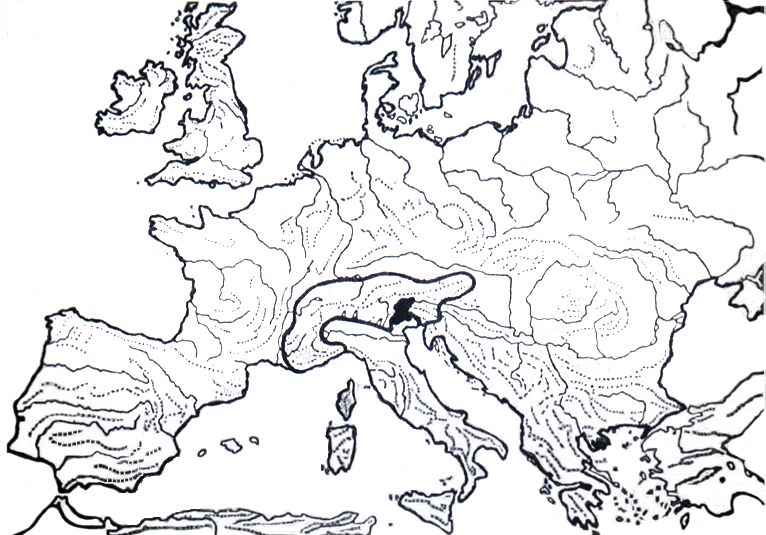 retour/back
retour/back
Fig. 2: Map of the distribution of the alpine marmot in the province of Belluno
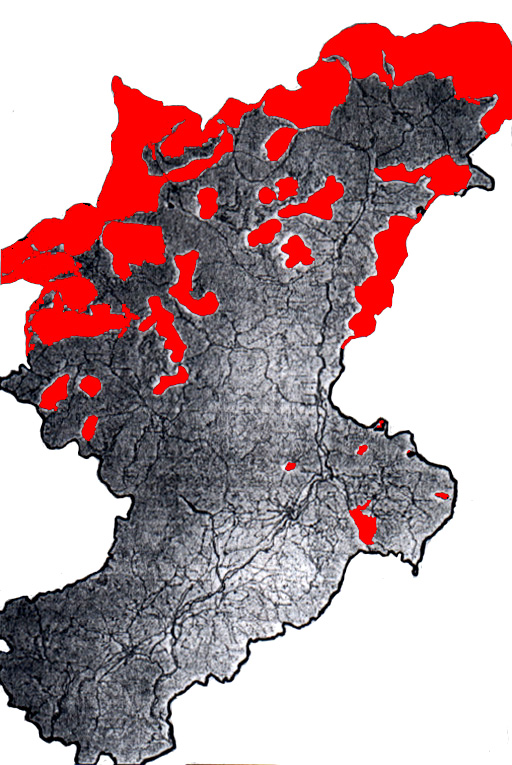 retour/back
retour/back
Fig. 3: Frequency of colonies per bands of altitude
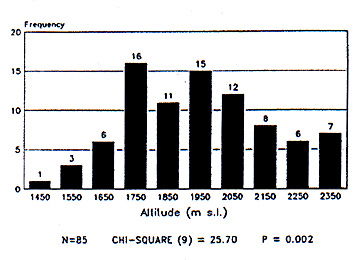 retour/back
retour/back
Fig. 4: Frequency of colonies per side of exposure
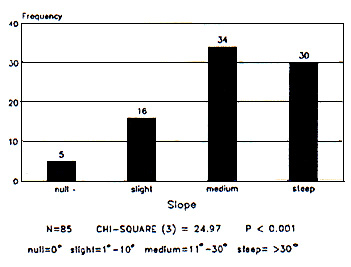 retour/back
retour/back
Fig. 5: Frequency of colonies per classes of slope
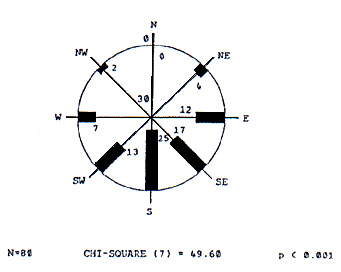 retour/back
retour/back
Fig. 6: Mean of openings per classes of slope
 retour/back
retour/back
Â
REFERENCES
REISIGL H. & KELLER R. (1990). Fiori e ambienti delle Alpi. Arti Grafiche Saturnia-Trento.
TURK A. & ARNOLD W. (1988). Thermoregulation as a limit to habitat use in alpine marmots (Marmota marmota). Oecologia, 76: 544-548.
Â
 retour/back
retour/back
 retour/back
retour/back
 retour/back
retour/back
 retour/back
retour/back
 retour/back
retour/back